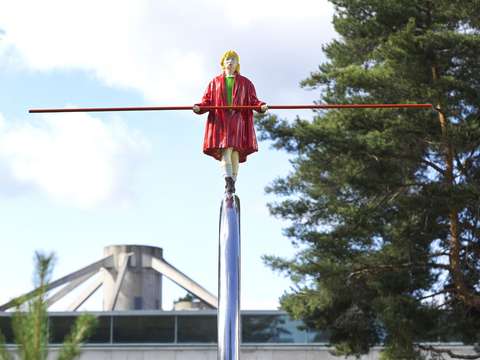New public artworks The Rope Dancer and Coffee Break communicate hope, uncertainty and courage
New artworks have been added to the sculpture parks of Exhibition Centre WeeGee and Hanaholmen at the end of August. Pekka Jylhä’s the Rope Dancer (originally Nuorallatanssija) is the fifth artwork in a sculpture park built from the collections of Espoo Museum of Modern Art, and Anne Meskanen-Barman’s bronze sculpture Coffee Break (originally Fikapaus) is a gift from the City of Espoo for Hanaholmen’s 50th anniversary.
The artwork commissioned from sculptor Pekka Jylhä further emphasises the status of the area as an important museum square in Espoo and the Ahertajantie road as a constantly developing and international hub of museums and art. The Rope Dancer was created in cooperation with the Espoo Museum of Modern Art (EMMA), the City of Espoo and Saastamoinen Foundation.
The Coffee Break sculpture was created in cooperation with EMMA and is part of Hanaholmen’s art collection, which currently includes around 300 pieces. The artwork was placed in front of the Hanaholmen main building, to the left of the corridor leading to the main entrance.
“The great thing about public art is that it makes art easily accessible and brings it close to people. The artworks that were revealed are relevant to the time and space. The Rope Dancer complements the collection of Exhibition Centre WeeGee and arouses curiosity toward museums. Hanaholmen Art Park is celebrating its 50th anniversary. It is a magnificent place that can be enjoyed by both international congress guests and local visitors,” says Susanna Tommila, Cultural Director of Espoo.
Pekka Jylhä’s The Rope Dancer is a portrayal of uncertainty about the future and courage that we need as the world around us shakes. The artist concretises this idea into a human figure that balances bravely on top of a large planet-shaped ring. The figure inspired by Jylhä’s own daughter is simultaneously in contact with the ground and reaching toward the sky up in the air. The bright colours of her clothes symbolise believing in a better future. “How could we leave the world a better place,” the artist ponders.
Anne Meskanen-Barman’s artwork Coffee Break (Fikapaus) depicts a set coffee table with its delicacies. Drinking coffee is an outright institution and a self-evident part of everyday life in Sweden and Finland. Serving coffee with cake or a bun is a hospitable gesture that communicates to the guest or guests that they are warmly welcome.
More information of the artworks:
